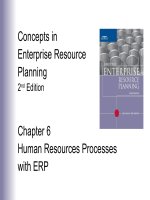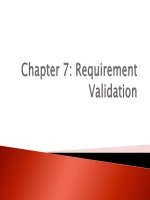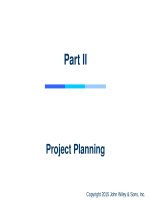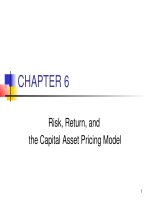Lecture Communication skill: Chapter 6 - Tracey Bretag, Joanna Crossman, Sarbari Bordia
Bạn đang xem bản rút gọn của tài liệu. Xem và tải ngay bản đầy đủ của tài liệu tại đây (204.48 KB, 13 trang )
Chapter 6
Writing genres
‘How we are expected to write
affects what we can write about.’
Copyright 2009 McGraw-Hill Australia Pty Ltd
PPTs t/a Communication Skills, by Bretag, Crossman and Bordia
1
6-1
Learning objectives
On completion of this chapter students will
know how to:
• identify key features of academic and
business texts
• recognise the difference between formal
and informal register
• use language appropriate to business
settings, taking into account issues of
power.
Copyright 2009 McGraw-Hill Australia Pty Ltd
PPTs t/a Communication Skills, by Bretag, Crossman and Bordia
2
6-2
What does ‘genre’ mean?
• ‘Genre’ means style, kind or type.
• Usually, ‘genre’ refers to a type of art or
literature.
• It can also refer to ways of speaking, types
of movies or plays, or any written document.
• In this context, ‘genre’ refers to the various
types of texts that students need to learn
and master.
Copyright 2009 McGraw-Hill Australia Pty Ltd
PPTs t/a Communication Skills, by Bretag, Crossman and Bordia
3
6-3
Academic genres
• The most common genre (type of text for
assessment) at Australian universities is the
essay.
• In business there are other genres which are
just as important:
– reports
– business letters
– email communication.
Copyright 2009 McGraw-Hill Australia Pty Ltd
PPTs t/a Communication Skills, by Bretag, Crossman and Bordia
4
6-4
Context and genre
• Factors that impact on genre:
–
–
–
–
context
situation
audience
purpose of the text.
• Consider each factor in relation to the essay
genre.
• Now think about the business context. How
is it different to the academic context?
Copyright 2009 McGraw-Hill Australia Pty Ltd
PPTs t/a Communication Skills, by Bretag, Crossman and Bordia
5
6-5
Business context
• Business reports written in workplace:
– audience = supervisor or ‘superior’
– usually someone with power
– much at stake for the organisation
• All documents have ‘regular, predictable
patterns of organisation’ (Swales & Feak
1994, p. 10).
Copyright 2009 McGraw-Hill Australia Pty Ltd
PPTs t/a Communication Skills, by Bretag, Crossman and Bordia
6
6-6
Activity 1
• See Activity 1 on pp 133–140 of your
textbook.
• Work in pairs.
• Divide your page into five columns with the
headings ‘personal email’, ‘business email’,
‘business letter’, ‘essay’ and ‘report’.
• Examine each text and identify the different
features. List the features of each text, using
the suggestions in the annotations and at
the bottom of the activity.
Copyright 2009 McGraw-Hill Australia Pty Ltd
PPTs t/a Communication Skills, by Bretag, Crossman and Bordia
7
6-7
Applying knowledge of
genres
• In your business studies you will need to
write in different genres, depending on the
course, assessment and preference of your
lecturers.
• Sometimes the genres will be ‘mixed’.
• Always be very clear about which genre is
expected before submitting work for
assessment.
Copyright 2009 McGraw-Hill Australia Pty Ltd
PPTs t/a Communication Skills, by Bretag, Crossman and Bordia
8
6-8
‘The vocabulary shift’
• Need to move from informal to formal writing
(academic and business contexts)
• Choice between verb + preposition or a
single verb (single verb is more formal).
• Example:
– The manager looked at the way tension builds
up during performance review meetings.
(less formal style)
– The manager investigated the way tension
develops during performance review meetings.
(more formal style)
Copyright 2009 McGraw-Hill Australia Pty Ltd
PPTs t/a Communication Skills, by Bretag, Crossman and Bordia
9
6-9
Activities 2 and 3
• Complete activities 2 and 3 on pp. 141–142
of your textbook.
Copyright 2009 McGraw-Hill Australia Pty Ltd
PPTs t/a Communication Skills, by Bretag, Crossman and Bordia
10
6-10
More advice on formality
• Avoid contractions (e.g. won’t = will not).
• Use the more appropriate formal negative
forms.
Example
– Do not write: The analysis didn’t yield any new results.
– Write: The analysis yielded no new results.
• Avoid run-on expressions such as ‘and so
forth’ and ‘etc’.
• Avoid using the first person ‘I’ and do not
address the reader as ‘you’. Focus on the
information rather than the writer or reader.
Copyright 2009 McGraw-Hill Australia Pty Ltd
PPTs t/a Communication Skills, by Bretag, Crossman and Bordia
11
6-11
More advice on formality
(cont.)
• Avoid asking rhetorical questions such as
‘What can be done?’
– Use statements instead, such as ‘X needs to be
considered’.
• Do not place adverbs at the beginning or
end of the sentence.
Examples
– Do not write: Then the solution can be
discarded.
– Write: The solution can then be discarded.
– Do not write: The profits have increased slowly.
– Write: The profits have slowly increased.
Copyright 2009 McGraw-Hill Australia Pty Ltd
PPTs t/a Communication Skills, by Bretag, Crossman and Bordia
12
6-12
Summary
• Different genres (texts) have distinct
requirements in terms of structure,
development, formality and acknowledgment
of sources.
• By learning and using the particular features
of texts, writers can produce easy-to-read
documents.
• The context, particularly the power relations
between the writer and receiver, affect the
formality of the document.
Copyright 2009 McGraw-Hill Australia Pty Ltd
PPTs t/a Communication Skills, by Bretag, Crossman and Bordia
13
6-13









